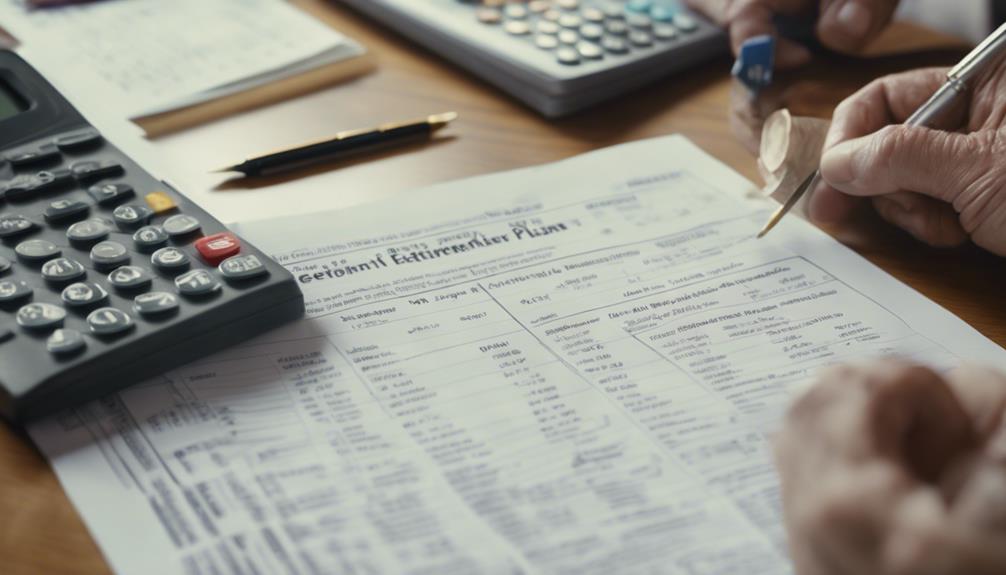As a teacher, you have access to various retirement plans like defined benefit pension plans, state-sponsored benefits, and tax-advantaged 403(b) and 457(b) plans. These options are crucial for securing your financial future. Getting professional financial advisory services can assist you in effectively navigating the complexities of retirement planning. Each plan offers distinct advantages to help you establish a solid foundation for retirement income. You can discover more about pension plans, contribution structures, and ways to maximize your retirement income sources. By exploring different retirement options, you will improve your knowledge of securing a stable financial future.
Key Takeaways
- Teachers enroll in state-sponsored pension plans like TRS.
- Automatic enrollment in defined benefit plans upon employment.
- Mandatory contributions deducted from salary for retirement benefits.
- Optional participation in supplemental plans like 403(b) for extra savings.
- Access financial advisors for personalized retirement planning guidance.
Teacher Pension Plans Overview

If you're a teacher in Texas, you're part of the Teacher Retirement System (TRS) pension plan, a defined benefit plan that determines your retirement benefits through a formula based on your years of service, final average salary, and a specific multiplier. The TRS pension plan requires a vesting period of 5 years, with a teacher contribution rate of 7.71% and an employer contribution rate of 9.48% in 2020.
To qualify for a teacher pension in Texas, you must meet specific retirement age and service criteria. Understanding that changes in employer contributions can impact both teacher rates and long-term retirement savings is important. Texas teacher pension contributions are mandatory, ensuring a structured approach to retirement planning for educators.
Planning for your retirement through the TRS pension plan involves considering the retirement age requirements and the benefits available within the defined benefit plan framework. Staying informed about any updates or changes to contribution rates is necessary to make informed decisions about your financial future.
State-Sponsored Retirement Benefits

State-sponsored retirement benefits provide Texas teachers with a structured pension plan based on factors like years of service and final average salary. Eligibility criteria, contribution percentages, and withdrawal rules are outlined by the state to guarantee teachers understand their retirement options.
State Options for Teachers
State-sponsored retirement benefits for teachers offer financial security through defined benefit pension plans, like the Texas Teacher Retirement System (TRS). TRS provides retirement plans based on a formula, not individual contributions, ensuring teachers have a stable income post-retirement.
New teachers in Texas typically join Tier 6 of the TRS pension system, where pension amounts are calculated using factors such as years of service, final average salary, and a multiplier. These state options for teachers, such as TRS, aim to provide retirement security by establishing specific criteria for eligibility and benefits.
Eligibility Criteria and Benefits
Teachers in Texas become eligible for the state-sponsored Teacher Retirement System (TRS) after completing a 5-year vesting period. Retirement benefits are determined by factors such as years of service and final average salary. The TRS offers defined benefit pension plans, ensuring a specific monthly payment throughout retirement.
New teachers in Texas are typically enrolled in Tier 6 of the TRS pension system. Unlike some retirement plans, the TRS pension value isn't based on individual contributions but rather on a formula set by the state. This system provides teachers with a secure source of income post-retirement, reflecting their dedication and service to the education sector.
Contribution and Withdrawal Rules
When contributing to the TRS pension plan in Texas, remember that 7.7% of your salary goes towards your retirement, while the state contributes 6.8%.
Withdrawal rules for state-sponsored retirement benefits in Texas are based on criteria like retirement age and years of service.
403(b) plans offer tax-deferred contributions, allowing educators to boost their TRS pension benefits. Withdrawal rules for 403(b) plans in Texas vary based on IRS regulations, with annual contribution limits and catch-up options.
Teachers can also set up IRAs or Roth IRAs to enhance their retirement savings, with lower contribution limits compared to 403(b) plans.
It's essential to understand these rules to make informed decisions about your retirement planning.
Understanding 403(b) and 457(b) Plans

When planning for retirement as an educator, understanding 403(b) and 457(b) plans is essential. These tax-advantaged programs offer various benefits such as employer matching contributions and different withdrawal rules with associated penalties.
Knowing the ins and outs of these plans can help you make informed decisions for a secure financial future.
Tax-Deferred Retirement Savings
Exploring tax-deferred retirement savings through 403(b) and 457(b) plans offers educators a strategic way to maximize their long-term financial security. These plans, tailored for educational and governmental employees, provide tax advantages and investment options like annuities and mutual funds.
Key points to keep in mind include:
- 403(b) and 457(b) plans are designed as tax-advantaged retirement savings programs.
- Both plans offer traditional and Roth account options with IRS-set annual contribution limits.
- Investment options within these plans include annuities and mutual funds for potential growth.
- Public schools typically provide 403(b) plans, while local governments offer 457(b) plans.
- Understanding fees, expenses, and investment choices is essential when selecting products within these tax-advantaged retirement plans.
Employer Matching Contributions
To maximize your retirement savings potential in 403(b) and 457(b) plans, understanding the impact of employer matching contributions is essential. Employer matching contributions play an important role in boosting your retirement savings by matching a portion of your contributions. Typically, these matches are a percentage of your salary, capped at a limit set by your employer.
This incentive encourages teachers to save for retirement and can greatly enhance your investment growth over time. Employers may match contributions dollar-for-dollar or at a lower rate, depending on the specific structure of the retirement plan. Hence, it's crucial to grasp your employer's matching contribution policy to fully capitalize on the retirement benefits offered to you.
Withdrawal Rules and Penalties
Understanding the withdrawal rules and penalties associated with 403(b) and 457(b) plans is crucial for effective retirement planning. Early withdrawals from these plans before age 59 ½ may incur a 10% penalty, although exceptions exist for situations like disability, death, or substantially equal periodic payments.
Additionally, required minimum distributions (RMDs) must commence at age 72 for both 403(b) and 457(b) plans. Some 403(b) plans may allow penalty-free withdrawals in cases of specific hardships or plan-related reasons. Being mindful of these rules ensures you make informed decisions regarding your pension fund and avoid unnecessary penalties in the future.
Contributions to Retirement Savings

Contributions to retirement savings for teachers in Texas involve a 7.7% deduction from your salary for the TRS Pension Plan, supplemented by a 6.8% contribution from the state. The TRS Pension Plan is a defined benefit plan that guarantees a secure retirement income based on your years of service and salary.
To enhance your pension benefits, you can opt for a 403(b) plan, a tax-deferred retirement plan. Contributions and earnings in a 403(b) plan grow tax-deferred, offering additional retirement savings opportunities for educators.
Within the 403(b) plan, you have various investment choices such as fixed annuities, variable annuities, and mutual funds, all certified by TRS. These options allow you to tailor your investment strategy based on your risk tolerance and retirement goals.
Consulting Financial Advisors for Guidance

Considering your retirement planning as a teacher in Texas, seeking guidance from financial advisors can provide valuable insights tailored to your specific needs and goals. Financial advisors can assist in analyzing your pension benefits, exploring supplemental savings options like 403(b) plans, and guiding you on investment choices to maximize your retirement income.
They've expertise in understanding state-specific retirement plans and can help you navigate complexities such as Social Security and government pension offset considerations. By consulting with a fiduciary financial advisor, you can guarantee unbiased recommendations that focus on your long-term financial security.
- Analyzing pension benefits
- Exploring supplemental savings options like 403(b) plans
- Guiding on investment choices
- Understanding state-specific retirement plans
- Managing Social Security and government pension offset considerations
Exploring Educators' Associations for Support

Exploring educators' associations for support can greatly enhance your retirement planning journey as a teacher in Texas. These associations provide valuable guidance on pension options, investment strategies, and financial planning tailored to educators.
By tapping into the resources offered, you can gain insights into maximizing your retirement savings. Workshops, seminars, and online tools are readily available through educators' associations to help you navigate the complexities of retirement planning effectively.
Additionally, these associations offer networking opportunities where you can connect with other educators and retirement experts, creating a supportive community to share experiences and knowledge.
Furthermore, educators' associations advocate for teacher rights and benefits related to retirement planning, ensuring that you're well-informed and empowered in making important financial decisions for your future.
Leveraging the support and resources provided by educators' associations can play an important role in securing a stable and fulfilling retirement as a teacher.
Maximizing Retirement Income Sources

To boost your retirement income sources as a teacher in Texas, leveraging defined benefit pension plans and options like 403(b) and 457(b) can be key. Here are some strategies to maximize your retirement income:
- Utilize Defined Benefit Pension Plans: Take full advantage of the pension plans offered to teachers in Texas to secure a reliable source of retirement income.
- Explore Defined Contribution Plans (403(b) and 457(b)): Consider contributing to these plans to supplement your pension benefits and increase your overall retirement savings.
- Supplement Retirement Savings: Make personal contributions to your retirement accounts to bridge any financial gaps and ensure a comfortable retirement.
- Seek Additional Income Opportunities: Explore part-time work or consulting post-retirement to add to your income streams.
- Get Professional Guidance: Consult state resources, financial advisors, and retirement counselors to get expert advice on maximizing your retirement income.
Retirement Planning During COVID-19

How has COVID-19 impacted your retirement planning as a teacher in Texas?
During these uncertain times, it's important to reassess your retirement plans. Consider the potential changes in pension funding and the impact of market volatility on your retirement investments. Seek guidance from financial advisors or utilize state resources to update your retirement planning strategies.
Stay informed about any legislative changes that may affect your teacher retirement benefits. It's vital to adapt and make informed decisions to secure your financial future. By staying proactive and seeking professional advice, you can navigate through these challenges and make the necessary adjustments to protect your retirement savings.
Keep a close eye on market trends, seek expert advice, and be prepared to adjust your retirement planning strategies as needed. Remember, staying informed and proactive is key to weathering the storm and ensuring a stable retirement.
Social Security and Teacher Pensions

When it comes to retirement planning as a teacher, understanding the interaction between Social Security and teacher pensions is essential.
In some states like Texas, teachers may not pay into Social Security due to specific pension plans, which can impact benefits.
The Government Pension Offset rule, for example, can reduce spousal Social Security benefits for teachers by two-thirds of their pension amount.
Social Security Basics
Educational employers in certain states, such as Texas, lack participation in Social Security, impacting the retirement benefits of teachers. Here are some essential facts for you to keep in mind:
- Teachers in CalSTRS may not pay into Social Security, affecting their retirement benefits.
- CalPERS teachers contribute to Social Security, influencing their pension plans.
- Government Pension Offset (GPO) rules can reduce spousal benefits for teachers.
- Understanding variations in Social Security participation within states is important for teachers.
- Verifying Social Security contributions through payroll deductions is vital for evaluating retirement benefits accurately.
Teacher Pension Options
Teachers in states like Texas, where participation in Social Security is lacking, often rely on the Teacher Retirement System (TRS) for their pension options. TRS provides defined benefit pensions, offering specific monthly payments for life post-retirement based on years of service, final average salary, and a pension multiplier. Since teacher pensions in Texas are not integrated with Social Security benefits, it is important to take into account additional savings or investment plans like 403(b) to enhance retirement income planning. Supplementing TRS pensions with such plans can help secure a more robust financial future. Below is a comparison table illustrating key points about TRS pensions and 403(b) plans:
| TRS Pensions | 403(b) Plans |
|---|---|
| Defined benefit structure | Voluntary retirement savings |
| Monthly payments for life | Contribution limits apply |
| Based on years of service | Tax advantages |
| Not integrated with Social Security benefits | Investment options vary |
| Impact retirement income planning | Employer matching possible |
Retirement Plan Eligibility
To qualify for retirement benefits in Texas, understanding the eligibility requirements for Social Security and the Teacher Retirement System (TRS) is essential. When it comes to retirement eligibility for teachers, dealing with the intricacies of the TRS pension plan is vital. Here are some key points to keep in mind:
- Texas teachers are covered under a defined benefit plan through the TRS pension.
- TRS pension eligibility requires a 5-year vesting period and meeting specific retirement age and service criteria.
- Social Security benefits for teachers may be impacted by the Government Pension Offset (GPO) rules.
- Teachers in Texas rely heavily on the TRS pension plan for retirement income.
- Supplementing retirement savings with personal savings and investment options like 403(b) plans can enhance overall financial security.
Ensuring Financial Security in Retirement

When planning for retirement, early consideration of factors like age, retirement timeline, and risk tolerance is essential to guarantee long-term financial security. As a teacher, ensuring financial stability in retirement is pivotal. You can benefit from defined benefit plans, such as pension plans, which offer a fixed monthly income based on your salary and years of service. Additionally, defined contribution plans like 403(b) and 457(b) allow you to contribute a portion of your salary, often matched by your employer, towards retirement savings. Supplementing retirement savings is key, particularly for educators who may not receive Social Security benefits. By taking advantage of these teacher benefits and making informed decisions based on your risk tolerance and retirement goals, you can work towards a comfortable and secure financial future. Consider the table below for a clearer comparison of defined benefit and defined contribution plans:
| Aspect | Defined Benefit Plans (Pension) | Defined Contribution Plans (403(b) and 457(b)) |
|---|---|---|
| Income Stability | Guaranteed fixed income | Income varies based on contributions |
| Contribution Structure | Employer-funded | Employee and employer contributions |
| Investment Control | Limited control over investments | More control over investment choices |
| Payout Flexibility | Fixed monthly payments | Flexibility in withdrawals and investment options |
Frequently Asked Questions
Which Retirement Plan Is Usually for Teachers?
For teachers, the retirement plan usually involves a defined benefit pension like the TRS Pension Plan in Texas. This type of plan guarantees a fixed annuity payout for life based on a predetermined formula, not contributions.
Additionally, teachers often have access to defined contribution plans like 403(b) to supplement their pension benefits. A combination of pension benefits and personal savings through retirement plans like 403(b) form the basis of teachers' retirement income.
Can I Retire With 20 Years of Teaching?
Yes, you can retire with 20 years of teaching experience in Texas if you meet the age and service credit requirements. While early retirement options may be available, benefits could be reduced.
Keep in mind that the Texas Teacher Retirement System bases benefits on a formula considering years of service and final average salary. Understanding the specific retirement plan rules and calculations is important for making informed decisions about retiring with 20 years of teaching experience.
Is a Teacher Pension Enough to Retire On?
Your teacher pension may not be adequate for retirement. While the TRS pension plan offers a valuable benefit, the average pension value may fall short of covering all your financial needs.
To guarantee a comfortable retirement, it's advisable to supplement your pension with personal savings. Long-term financial planning and prudent saving strategies can help bridge the gap between your pension payouts and living expenses in retirement.
Do Teachers Get Offered a 401k?
You don't get offered a 401(k) as a teacher, but you might've access to a 403(b) plan. This retirement plan is tailored for educators and certain non-profit employees.
It allows you to contribute pre-tax earnings, growing tax-deferred until retirement. Annuity options can be part of the investment mix, with IRS-set contribution limits and potential employer matching.
It's a solid retirement savings tool for educators.
Conclusion
To sum up, teachers have several options for retirement planning, including pension plans, 403(b) and 457(b) plans, and social security benefits. By consulting financial advisors and maximizing income sources, educators can guarantee financial security in retirement.
For instance, a teacher who diligently saves in a 403(b) plan throughout their career can enjoy a comfortable retirement with a steady income stream. It's crucial for teachers to start planning early and make informed decisions to secure their financial future.









